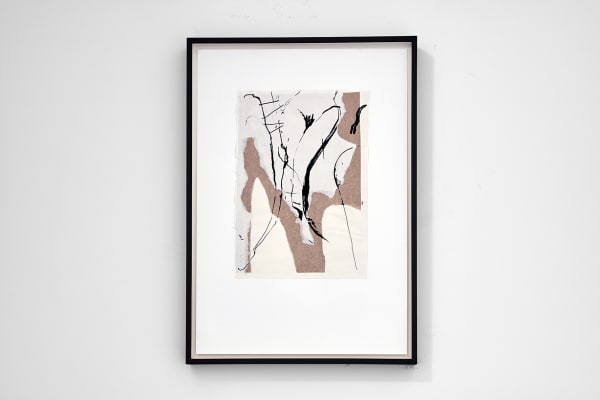-
Bert Theis: Pays sages 1991
Drawings and Collages from the Bert Theis Archive. Text by Marco Scotini -
A collaborative project between the Bert Theis Archive and
Erna Hecey Gallery
At crossroads between figurative landscapes and abstract compositions, the exhibition "Pays sages 1991" assembles a corpus of Bert Theis' drawings and collages that have never yet been revealed to the public. Theis produced these sketches in Italy between 1990 and 1992, while studying at the Accademia di Belle Arti di Roma. Thanks to the major retrospective "Bert Theis: Building Philosophy-Cultivating Utopia" held at MUDAM Luxembourg in spring 2019, a sizeable part of Bert Theis's activity prior to the 1990s emerged, revealing works produced before the pavilions and platforms for which he achieved international acclaim.
-
-
'[Theis'] prominent use of white as a strong, persistent and anti-pollutant sign'
The particularity of this group of enigmatic collages from 1991 is the important role they play in marking the transition from his truly figurative collages of the 1980s (in which Max Ernst is a sort of spiritual forefather) to his prominent use of white as a strong, persistent and anti-pollutant sign in subsequent work. In fact, Theis would repeatedly return to collage in the years that followed, mainly in pieces connected to city-and landscapes, as in the well-known Agglovilleseries.
-

L'art de la peinture, 1994, Photographic print (series)
-
 Shadow Fixing III, 1993, Colour print on aluminium, 50 x 100 cm
Shadow Fixing III, 1993, Colour print on aluminium, 50 x 100 cm -

Pays sage 10, 1991
Collage, white and coloured paper, ink
29,5 cm x 21,5 (unframed)
51 x 36 cm (framed)Inquire
-

-
 Philosophical Platform, 1997 at Skulptur-Projekte, Münster, 1997, Curated by Kasper König
Philosophical Platform, 1997 at Skulptur-Projekte, Münster, 1997, Curated by Kasper König -
"I'm a builder of platforms. My platforms, [...] are social spaces, where all kinds of activities can freely happen." -Bert Theis
Bert Theis (1952-2016) was an artist and activist who explored through his work themes linked to ecological policies, urbanisation and gentrification. His international acclaim arose at the 1995 Venice Biennale, where he represented Luxembourg. Theis was mostly known for his large site-specific urban installations in densely populated areas, based on public platforms and pavilions in parks. In the 2000s, he organized and directed two long-term projects – Isola Art Center and out-Office for Urban Transformation – in collaboration with Mariette Schiltz, around the conflict opposing the inhabitants of the Isola district, Milan City government and an American multinational company.
Although most of his works were created in situ, Bert Theis also participated in many international exhibitions and events. Most recently, a monographic exhibition was held at the MUDAM -Musée d'Art Moderne du Luxembourg Grand Jean-Duc entitled Building Philosophy -Cultivating Utopia (2019), which was accompanied by a series of actions under the name of Archipelago Bert Theis. Other major personal exhibitions include Padiglione d’Arte Vivente, Torino, Italy (2015), Erna Hecey Gallery, Brussels (2008), MAMCO –Musée d’art moderne et contemporain, Geneva, Switzerland (2007), and Erna Hecey Gallery, Luxembourg (1999 and 2003).
He has been part of numerous international group exhibitions, i.e. MUDAM, Luxembourg (2020); Le Printemps de Septembre, Toulouse (2018); MOCAK – Museum of Contemporary Art in Krakow (2016); CNAP and Galerie Fernand Léger, Ivry-sur-Seine (2015); Pavillon de l’Arsenal, Paris , (2016); Vienna Secession, Austria (2014); MAXXI, Museo nazionale delle arti del XXI secolo, Rome (2014); Castello di Rivoli, Torino, Italy (2013); Mudam, Luxembourg (2012, 2006); the Venice Biennale (2011); The 10th Istanbul Biennial (2007), and Skulptur Projekte Münster (1997). Biennale de Venise (1995).
Permanent installations can be found at Parc de la Butte du Chapeau Rouge, Paris; Luicciana di Cantagallo, Italy; MNHA Musée National d’Histoire et d’Art du Luxembourg, Belval and Place de l’Europe - Kirchberg, Luxembourg.















